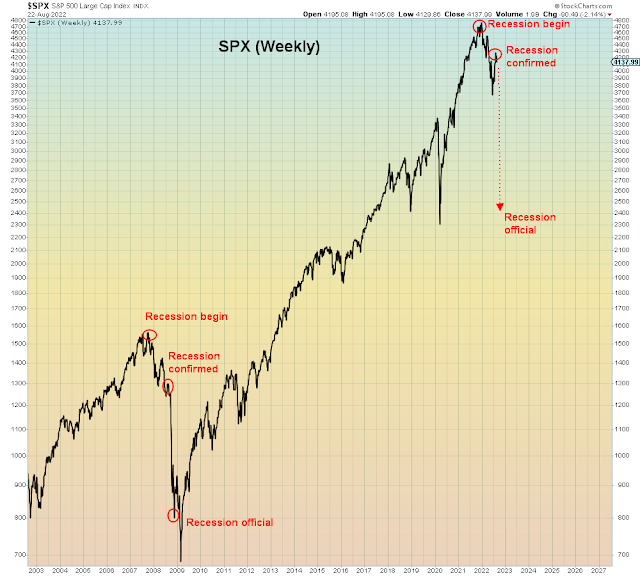As of this writing, Japan and China are both easing while Europe and the U.S. are both tightening. It's the biggest global policy divergence we've seen in our lifetimes. Despite the falling Yen, Japan has steadfastly maintained easy monetary policy. Why? Because they know what happens when you don't respect the zero bound. Consider that Japan's inflation rate is currently 2% while the U.S. inflation rate is 9%, even though Japan is easing and the Fed is record tightening. Which makes even less sense when you consider the dollar is sky-rocketing and the Yen is collapsing. It only makes sense in the context of a country that has been caught in a liquidity trap for decades. Which means that consumers are averse to borrowing money, whereas in the U.S., consumers are not averse at all. YET.
China is also well along the path to liquidity trap. In 2008, China pulled the world out of recession as their GDP growth rate was 14% that year. It never went negative during that global recession. Subsequently, they built massive empty "ghost cities" and real estate development is now 30% of GDP. So it is they find themselves at a point wherein lower interest rates no longer spur demand.
"Taken together, the data shows banks are flush with cash but are struggling to boost lending to customers against the backdrop of weak growth and turmoil in the property market.
The data is a classic sign of a liquidity trap. Liquidity is ample, but no one wants it. Under these circumstances, monetary policy can do little to support the economy”.
Sound familiar?
China's GDP is collapsing faster than Wall Street can keep up. Not a month goes by when they don't revise lower China's full year growth rate. Only a serial fool would believe that this current GDP reduction will be the last.
Now consider that in all of the major stumbles since 2008: 2015, 2018, and 2020, global central banks were all on the same page with respect to monetary bailout. Whereas now, they are diverging massively between Asia and Europe /U.S. /Canada /Australia etc.
What happens when there is a global collapse and two of the largest central banks are already flailing away. And the remaining central banks refuse to bailout markets?
What happens is a far worse crash that damages markets, the economy, and consumer confidence. Followed by a clusterfucked bailout and loss of confidence in central banks.
Many of today's bulls are claiming that this currently collapsing housing bubble is not as big a risk as 2008 because there's "no subprime this time". What they don't acknowledge is that most of the global economy IS subprime this time.
This epic risk of a global liquidity trap combined with global monetary policy divergence are the two biggest economic and financial risks, however they are completely ignored. Investors are currently betting on an imaginary pivot to an imaginary Fed bailout followed by an imaginary global recovery.
And no one will tell them any different, because today's financial press have the attention span of a coked up flea. Today's financial press are eagerly monetizing false optimism because that is their largest market for readers and they don't want their audience to be disappointed by reality. They have gladly sacrificed all shred of credibility on the altar of continuous monetary bailout. They are in the exact same closed loop as investors, incapable of seeing the risk to their groupthink circle jerk.
In the U.S., the biggest beneficiary of "inflation" was corporate profit. So, bringing prices down, axiomatically means lowering profit margins from record highs back down to historic levels.
What we see from this chart is that after the pandemic, it took a mere one year for corporate profits to skyrocket to new all time highs. Versus four years in Y2K and 2008.
Profit is 90% correlated to CPI (not shown).
In 1980, Paul Volcker purposely engineered a recession to bring down inflation, because he knew that he had ample dry powder in case he needed to cut rates to bring back the economy. In the event, he brought rates down 12% to offset the worst recession since the Great Depression.
This Volckerized Fed has a 2.25% rate buffer on the economy. And yet untold numbers of pundits have been pounding the table for them to raise rates as quickly and brutally as possible. To bring down "inflation".
At no time in this entire debacle did the Treasury market believe that inflation was ANYTHING like 1980.
What these people all need is an education on economics. And they're going to get one.
When it's officially too late.
"The velocity of money is a measurement of the rate at which money is exchanged in an economy. It is the number of times that money moves from one entity to another. It also refers to how much a unit of currency is used in a given period of time. Simply put, it's the rate at which consumers and businesses in an economy collectively spend money"






